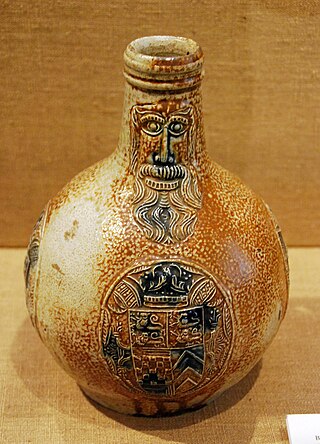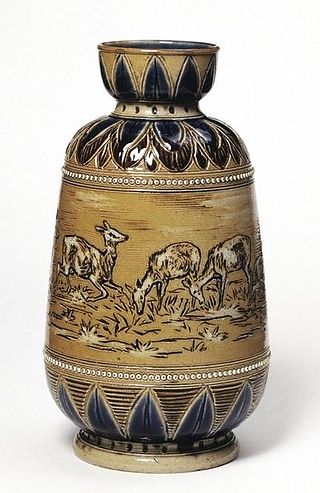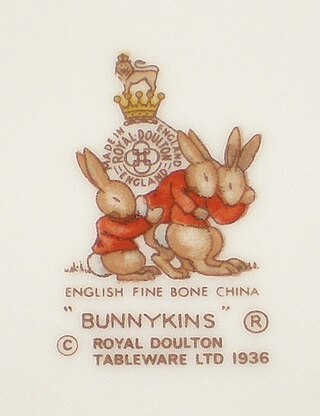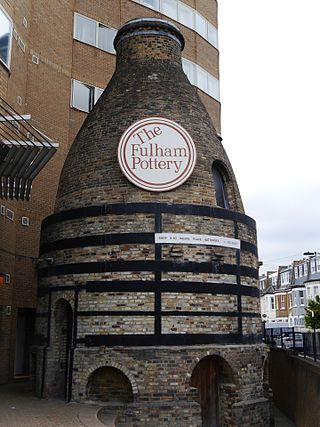
Clarice Cliff was an English ceramic artist and designer. Active from 1922 to 1963, Cliff became the head of the factory creative department.

Stoneware is a broad term for pottery fired at a relatively high temperature. A modern definition is a vitreous or semi-vitreous ceramic made primarily from stoneware clay or non-refractory fire clay. End applications include tableware, decorative ware such as vases.

Salt-glaze or salt glaze pottery is pottery, usually stoneware, with a glaze of glossy, translucent and slightly orange-peel-like texture which was formed by throwing common salt into the kiln during the higher temperature part of the firing process. Sodium from the salt reacts with silica in the clay body to form a glassy coating of sodium silicate. The glaze may be colourless or may be coloured various shades of brown, blue, or purple.

Langley Mill Pottery was located in Langley Mill, Derbyshire on the Derbyshire – Nottinghamshire border. From its establishment in 1865 to its final closure in 1982, the pottery went through five distinct periods of ownership, producing a wide range of stoneware ranging from salt glazed ink bottles, utilitarian items and tableware to high quality and original art pottery.

Wedgwood is an English fine china, porcelain and luxury accessories manufacturer that was founded on 1 May 1759 by the potter and entrepreneur Josiah Wedgwood and was first incorporated in 1895 as Josiah Wedgwood and Sons Ltd. It was rapidly successful and was soon one of the largest manufacturers of Staffordshire pottery, "a firm that has done more to spread the knowledge and enhance the reputation of British ceramic art than any other manufacturer", exporting across Europe as far as Russia, and to the Americas. It was especially successful at producing fine earthenware and stoneware that were accepted as equivalent in quality to porcelain but were considerably cheaper.

Royal Doulton is an English ceramic and home accessories manufacturer that was founded in 1815. Operating originally in Vauxhall, London, and later moving to Lambeth, in 1882 it opened a factory in Burslem, Stoke-on-Trent, in the centre of English pottery. From the start, the backbone of the business was a wide range of utilitarian wares, mostly stonewares, including storage jars, tankards and the like, and later extending to drain pipes, lavatories, water filters, electrical porcelain and other technical ceramics. From 1853 to 1901, its wares were marked Doulton & Co., then from 1901, when a royal warrant was given, Royal Doulton.
W. Moorcroft Limited is a British art pottery manufacturer specialising in richly decorated earthenware. based at Burslem in Stoke-on-Trent, England. The company was founded by William Moorcroft in 1913.

Mintons was a major company in Staffordshire pottery, "Europe's leading ceramic factory during the Victorian era", an independent business from 1793 to 1968. It was a leader in ceramic design, working in a number of different ceramic bodies, decorative techniques, and "a glorious pot-pourri of styles - Rococo shapes with Oriental motifs, Classical shapes with Medieval designs and Art Nouveau borders were among the many wonderful concoctions". As well as pottery vessels and sculptures, the firm was a leading manufacturer of tiles and other architectural ceramics, producing work for both the Houses of Parliament and United States Capitol.
(Arthur) Leslie Harradine (1887–1965) was one of Royal Doulton's premier, and most prolific, figurine modellers from 1920 until the mid-1950s.

Victorian majolica properly refers to two types of majolica made in the second half of the 19th century in Europe and America.

Royal Doulton Bunnykins tableware and figurines are popular ceramic designs manufactured as nursery dishes and collectible figurines. The chinaware line originated with artwork by Sister Mary Barbara Bailey, the daughter of Cuthbert Bailey, general manager of Doulton during the 1930s. Unbeknownst to the public, Mary Barbara Bailey was not a professional illustrator, but a nun in the Augustinian Canonesses of the Lateran. Sister Mary Barbara provided illustrations to the designers of Doulton & Co. to be used on tableware. Six Bunnykins figurines were produced based on Sister Mary Barbara's illustrations in 1939 and were designed by Charles Noke. Discontinued during World War II, Bunnykins figurines were not reintroduced until 1969. Bunnykins continued to be produced in England until 2005. Bunnykins figurines and tableware are currently produced in Asia.
John Doulton was an English businessman and manufacturer of pottery, a founder of the firm that later became known as Royal Doulton. John Doulton married Jane Duneau, a widow from Bridgnorth in Shropshire, who died on 9 April 1841. They had eight children, including Sir Henry, MP Frederick, Josiah and Alfred.

Charles Vyse, was an English studio potter, noted for producing colourful figurines of characters seen on London streets.

Art pottery is a term for pottery with artistic aspirations, made in relatively small quantities, mostly between about 1870 and 1930. Typically, sets of the usual tableware items are excluded from the term; instead the objects produced are mostly decorative vessels such as vases, jugs, bowls and the like which are sold singly. The term originated in the later 19th century, and is usually used only for pottery produced from that period onwards. It tends to be used for ceramics produced in factory conditions, but in relatively small quantities, using skilled workers, with at the least close supervision by a designer or some sort of artistic director. Studio pottery is a step up, supposed to be produced in even smaller quantities, with the hands-on participation of an artist-potter, who often performs all or most of the production stages. But the use of both terms can be elastic. Ceramic art is often a much wider term, covering all pottery that comes within the scope of art history, but "ceramic artist" is often used for hands-on artist potters in studio pottery.
John Beswick Ltd, formerly J. W. Beswick, was a pottery manufacturer, founded in 1894 by James Wright Beswick and his sons John and Gilbert in Longton, Stoke-on-Trent. In 1969, the business was sold to Doulton & Co. Ltd. The factory closed in 2002 and the brand John Beswick was sold in 2004. The pottery was chiefly known for producing high-quality porcelain figurines such as farm animals and Beatrix Potter characters and have become highly sought in the collectables market. Pronunciation of Beswick is as at reads, Bes-wick. This information was from employees who worked at the original Beswick factory.

Shelley Potteries, situated in Staffordshire, was earlier known as Wileman & Co. which had also traded as The Foley Potteries. The first Shelley to join the company was Joseph Ball Shelley in 1862 and in 1896 his son Percy Shelley became the sole proprietor, after which it remained a Shelley family business until 1966 when it was taken over by Allied English Potteries. Its china and earthenware products were many and varied although the major output was table ware. In the late Victorian period the Art Nouveau style pottery and Intarsio ranges designed by art director Frederick Alfred Rhead were extremely popular but Shelley is probably best known for its fine bone china “Art Deco” ware of the inter-war years and post-war fashionable tea ware.

The Fulham Pottery was founded in Fulham, London, by John Dwight in 1672, at the junction of New King's Road and Burlington Road, Fulham, not far from Putney Bridge. Dwight is the earliest clearly documented maker of stoneware in England, although immigrant Dutch or German potters were probably active several decades before. By 1690 there was a rival stoneware operation in Fulham, run by the Dutch Elers brothers, who after a few years went off to become important early figures in transforming the Staffordshire pottery industry.
Samuel Augustus Weller, one of the pioneer pottery manufacturers of Ohio in the United States, founded the S.A. Weller Pottery in Fultonham, Ohio, in 1872. In 1882 he moved the business to Zanesville, Ohio, and for more than a half-century Weller Pottery produced both utilitarian pieces and more decorative art pottery lines.

Ceramic art is art made from ceramic materials, including clay. It may take varied forms, including artistic pottery, including tableware, tiles, figurines and other sculpture. As one of the plastic arts, ceramic art is a visual art. While some ceramics are considered fine art, such as pottery or sculpture, most are considered to be decorative, industrial or applied art objects. Ceramic art can be created by one person or by a group, in a pottery or a ceramic factory with a group designing and manufacturing the artware.














